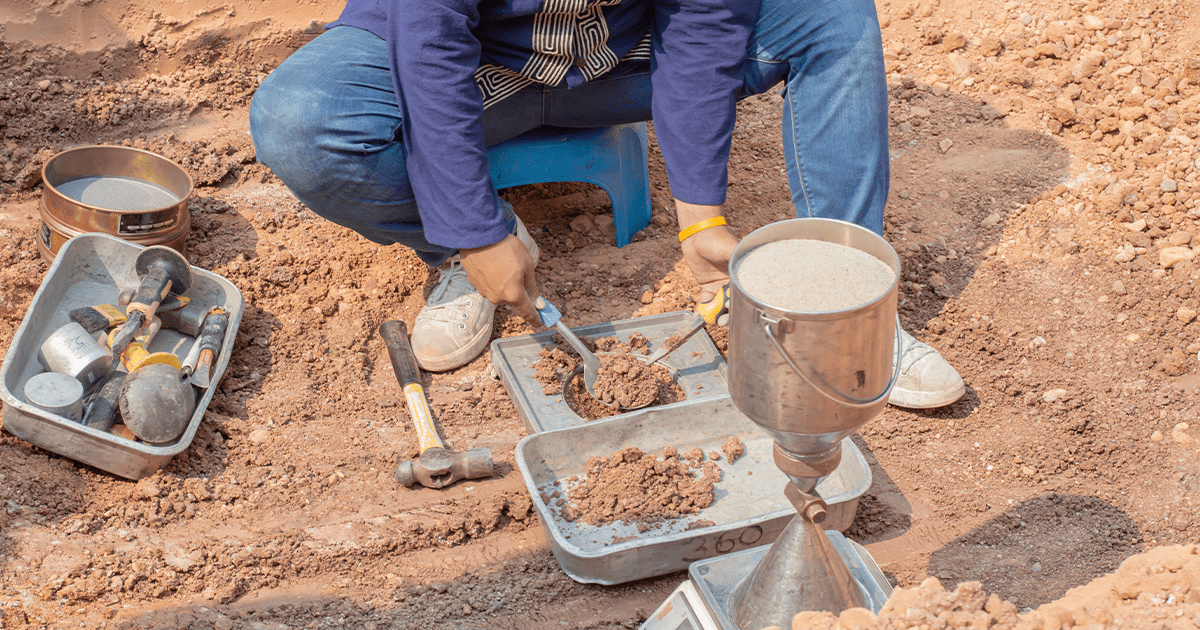
Construction and geotechnical testing
From concrete and asphalt to construction site substrates like clay and rock, the proper quality and characterization of construction and engineering materials is critical to a construction project’s long-term success. The importance of perfecting and using quality construction materials dates back millennia, for example to the Romans and their refinement of concrete recipes and production using pozzolanic and quicklime materials.[1] Even today, we learn that some sand types such as desert sand are inadequate for direct use in modern concrete due to their negative contribution to the necessary compressive strength of the concrete.[2] Should a contractor attempt a financial shortcut by using cheaper, less appropriate sand in their concrete mixes, future maintenance costs may go up at the least, or lives may be lost in a structural collapse at the worst.
Similarly, what is found and to be put under a construction site is also important. In this case, a sub-branch of materials testing is introduced in the form of geotechnical testing (or geotechnical investigation). With this kind of testing, the soil and rock is examined for load-bearing and seismic (i.e., engineering) properties to ensure any proposed structure can safely and durationally last over a specified period of time.[3] Geotechnical engineers examine soil and rock mechanics, soil-structure interactions, geomechanics, ground improvement strategies, and various stabilities, as well as characterize geomaterials with laboratory and in situ sampling and analysis.[4]
In both construction materials testing and geotechnical testing, a wide variety of physical, chemical, geological, and physics-based examinations take place before and during construction projects as a matter of good industry practice, as well as due to regulatory- and code-based requirements. As with many other industries, human and monetary losses—in this case from construction and engineering failures, accidental and malicious—have driven regulators at the federal, state, and local level to put testing requirements in place to better ensure human safety and improve the overall quality of the construction industry. This is discussed in greater detail in the next section.
Why is laboratory testing of construction and earth materials important to modern society?
From hurricanes and earthquakes to improper material choice and installation during construction, modern structures that society often takes for granted can become compromised and unsafe for use. Most of us expect our bridges, apartment buildings, and brick homes to be constructed to a high standard with quality materials so as to limit the effects of natural disasters and human error. That quality in part comes with the help of laboratory and on-site analyses that ensure construction materials are produced to a certain standard before being installed, and that geotechnical aspects of the site where the materials will be used are are more than sufficient (i.e., not simply having “met the code,” which represents a minimum requirement[5] to ensure the safety of the proposed structure for a given period of time.
In 2022, industry veteran Robert C. Rabeler published his findings regarding 10 geotechnical failure cases, including causes and lessons learned. In that work, Rabeler noted that failures typically occurred “due to poor understanding of the risks involved, a lack of proper geotechnical engineering involvement, poor communication, and a tendency to not spend enough resources to complete a thorough design.”[6] He added that the risks of geotechnical failure (such as loss of life and investment) could have been limited through retaining the most knowledgeable and well-trained geotechnical services, being willing to pay for such services, and ensuring those engineers are actively involved with design and construction efforts.[6]
Earlier work by Cummings and Kenton found “substandard [geotechnical] investigations, dishonesty and deceit, approval of substandard reports by reviewing agencies, and political influence” as factors in geotechnical failures, highlighting that such failures are people-related issues, not natural event issues. Essentially, their argument was “humans are fallible, including in the laboratory, and the ‘highest quality of professional investigation’ is required to ensure those risks are minimized.”[5] The requirement for the “highest quality of professional investigation” aligns with the work of Rabeler and highlights how geotechnical testing in itself isn’t enough for the benefit of society; that testing must be done well, with ethical, professional, and quality motivations driving it. In other words, choosing quality construction and earth materials testing is absolutely critical to ensuring the best outcomes for a society that depends on safe infrastructure (e.g., bridges and highways) and buildings (e.g., homes and office towers). Those outcomes include not only improved human safety and security (e.g., construction and seismic testing in earthquake-prone regions[7]), but also monetary benefit. For example, quality geotechnical investigation that incorporates proper laboratory and in situ’ testing can help reduce the costs for ground improvement and overall construction, as well as reduce the chance for future disputes.[3][8] In fact, foundation-related problems have been found to cost the construction industry upwards to $3 billion annually.[8]
Finally, we also find construction and geotechnical laboratory testing facilities at the upper echelons of our society, as institutions driven to advance the state of the art in construction materials and engineering so future generations can benefit from past and current experience. For example, the U.S. Department of Transportation, Federal Highway Administration’s Turner-Fairbank Highway Research Center hosts its own geotechnical laboratory, with the goal of advancing “the state of the practice of geotechnical engineering in transportation and [developing] innovative solutions for practical transportation issues,” while also partnering “with various transportation agencies in advancing innovative technologies and solutions” in the field of materials testing and research.[9] The output of these and similar laboratories further benefits society by informing future regulation, building code, and standardized practices, making structures safer than ever.
How LabLynx’s ELab LIMS Solution Can Help Support Construction and Engineering Lab
Every construction and engineering laboratory possesses a unique blend of infrastructure, industry standards, and customer requirements. All laboratories share a common goal: quickly delivering consistent, reliable test results. This becomes challenging when your materials testing lab relies on manual processes, paper forms, and spreadsheets stored on various computers.
The LabLynx ELab LIMS is designed to enhance and automate your workflows, ensuring compliance with ASTM and other standards while eliminating error-prone manual work. Your construction and engineering lab will produce higher-quality and faster results while boosting productivity with the powerful features in ELab LIMS.
The LabLynx LIMS offers a wide array of features to enhance your materials testing lab’s productivity, replace manual processes, eliminate common pre-analytical errors, and elevate quality testing. These LIMS features help construction and engineering labs save lives by reducing variability and errors in testing while also reducing pre-construction, construction, and post-construction costs by improving efficiency.
References
- Chandler, D.L. (6 January 2023). “Riddle solved: Why was Roman concrete so durable?”. MIT News. Massachusetts Institute of Technology. Retrieved 15 November 2023. https://news.mit.edu/2023/roman-concrete-durability-lime-casts-0106
- Akhtar, Mohammad Nadeem; Jameel, Mohammed; Ibrahim, Zainah; Muhamad Bunnori, N.; Bani-Hani, Khaldoon A. (1 June 2023). “Development of sustainable modified sand concrete: An experimental study” (in en). Ain Shams Engineering Journal: 102331. doi: 10.1016/j.asej.2023.102331. https://linkinghub.elsevier.com/retrieve/pii/S2090447923002204
- Patel, Anjan (2019), “Geotechnical investigation” (in en), Geotechnical Investigations and Improvement of Ground Conditions (Elsevier): 87–155. doi: 10.1016/b978-0-12-817048-9.00009-3. ISBN: 978-0-12-817048-9. Retrieved 2023-11-15. https://linkinghub.elsevier.com/retrieve/pii/B9780128170489000093
- “Geotechnical”. University of Delaware. 2022. Retrieved 15 November 2023. https://ce.udel.edu/research/research-overview/geotechnical/
- Cummings, D.; Kenton, F.J. (2004). “Eleven Case Studies of Failures in Geotechnical Engineering, Engineering Geology, and Geophysics: How They Could Have Been Avoided” (PDF). Proceedings of the Fifth International Conference on Case Histories in Geotechnical Engineering. Missouri University of Science and Technology. ISBN: 1887009078. Retrieved 15 November 2023. https://scholarsmine.mst.edu/cgi/viewcontent.cgi?article=2518&context=icchge
- Rabeler, Robert C. (17 March 2022). “Geotechnical Failure Case Studies—Lessons Learned” (in en). Geo-Congress 2022 (Charlotte, North Carolina: American Society of Civil Engineers): 301–315. doi: 10.1061/9780784484036.031. ISBN: 978-0-7844-8403-6. http://ascelibrary.org/doi/10.1061/9780784484036.031
- Syed, Z. (30 March 2023). “Why most countries don’t have enough earthquake-resilient buildings”. Popular Science . Retrieved 15 November 2023. https://www.popsci.com/environment/earthquake-engineering-buildings/
- “Benefits of geotechnical analysis in evaluating soil-bearing capacityand foundation settlement control”. Utilities One. 18 July 2023. Retrieved 15 November 2023. https://utilitiesone.com/benefits-of-geotechnical-analysis-in-evaluating-soil-bearing-capacityand-foundation-settlement-control
- “Geotechnical Laboratory Overview”. Office of Research, Development, and Technology at the Turner-Fairbank Highway Research Center. 21 July 2022. Retrieved 15 November 2023. https://highways.dot.gov/research/laboratories/geotechnical-laboratory/geotechnical-laboratory-overview




